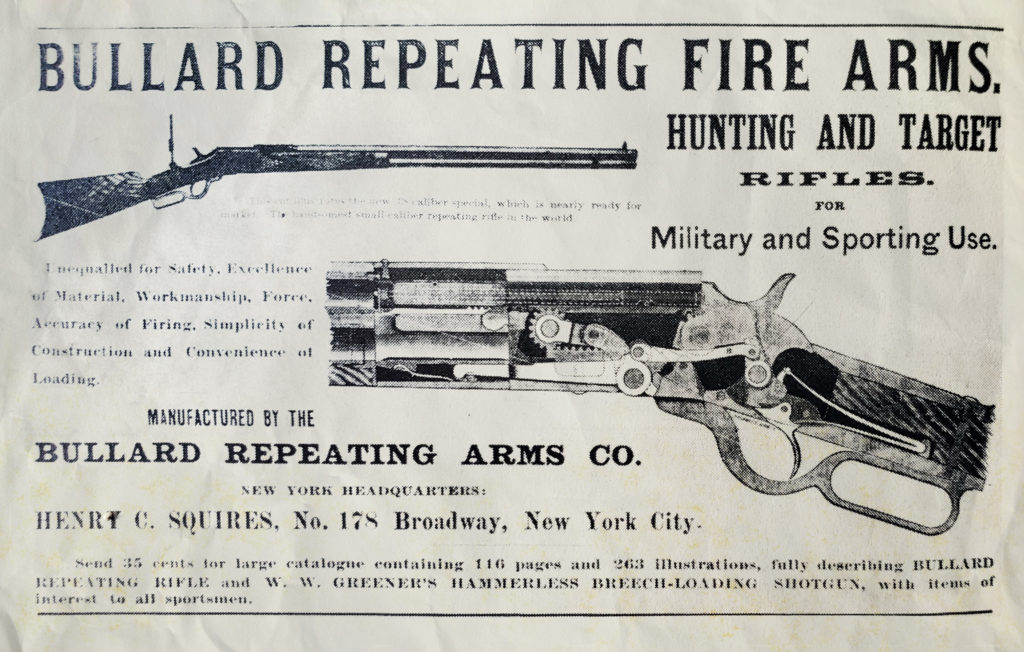Winchester, Remington and Marlin had practically cornered both the single-shot and repeating rifle markets by the time James H. Bullard patented one of the smoothest lever-action rifles ever manufactured. Born in Poultney, Vt., on May 14, 1842, Bullard was a mechanical genius who patented numerous devices (more than 100 from 1872 to his death at age 71 on March 26, 1914), including a steam-driven automobile, and was a far more talented inventor than a businessman. A disabling childhood leg injury kept him out of the Civil War, but he worked for a couple of machine companies until 1874, when he became a master mechanic for Smith & Wesson. By early 1882 in Springfield, Mass., he’d established J.H. Bullard & Co., which that May became the Bullard Repeating Arms Association and on Oct. 11, 1883, the Bullard Repeating Arms Co. Two years later, intent on pursuing his other inventions, Bullard left active management of the company, which dissolved in 1891.
The Bullard rifle is somewhat of an outlier, given the company offered both a repeating model, patented on Aug. 16, 1881, and a wholly distinct single-shot model, patented on July 6, 1886. Both utilized a glassy smooth, gear-driven action that has never been equaled in ease of operation. The Bullard repeater, a precision instrument of exceptional quality, was unique in that a user loaded it from bottom of theframe. It came in two frame sizes. The small-frame models were chambered for the .32-40 Winchester/Marlin and .38-45, the large for a Bullard-designed cartridge in the more powerful .40-60, .40-75, .45-70 and .45-85 calibers. On special order the latter was also available in .50-90 and .50-115. A military musket in .45-70 was another choice, as well as a carbine version with a 22-inch barrel. Overall, the company produced an estimated 10,600 to 12,000 repeating rifles.

Structurally speaking, the single-shot Bullard was an altogether different rifle, with a comparatively petite, thin frame. That said, it was every bit the repeater’s equal in quality. Its manufacturing details are largely unknown, but the single-shot model was produced in far smaller quantities. It was offered in .32, .38, .45 and .50 caliber (the last is the scarcest today and brings a hefty premium), though one could purchase a model with an interchangeable barrel, such as the one pictured above. This particular rifle was custom converted to the rimfire .22 long rifle cartridge, which was not in the original caliber offerings, though it does have the Schuetzen style, or Swiss, butt plate offered by the Bullard factory. Like many other popular guns of the day, the Bullard was available in virtually any configuration special ordered by the customer.
By 1884 San Francisco–based Curry & Bros. was selling the repeating rifle, and within a few years Bullard became known throughout the West. Theodore Roosevelt purchased and used a special order six-shot express model in the powerful .50-115 caliber. The $35 price tag in 1886 (roughly $1,100 in today’s dollars) for a plain version without checkered stocks or special sights was higher than many could afford. Those who did shell out felt they got their money’s worth. Montana hunter William Alonzo “Doc” Allen was among the latter. Once a staunch Winchester owner, he switched over to the Bullard in the late 1880s. Reflecting on his adventures in 1903, he stated, “Death had stared me in the face many times before, in many different forms, and the old Bullard had never been found wanting.”

Cost, however, ultimately did help do in Bullard Repeating Arms. The very complex internal designs of both the Bullard repeater and the Bullard single shot were as fine as Swiss watches. Competing firearm companies sold their rifles at considerably lower prices. For instance, the Winchester Model 1866 lever-action repeating rifle went for $19.50, while Marlin-Ballard and Maynard rifles were similarly priced. Bullard certainly outdid other manufacturers when it came to design and craftsmanship, and the company distributed a handful of catalogs and brochures, but it was never big on mass production or standardization. As with any advance in technology, timing is everything, and Bullard’s superb rifle line just couldn’t keep up with companies that had mastered the art of mass production, quality and efficiency rolled into one at prices to meet the needs of not only the wealthy but also the working people of the day. Having owned at least two different Bullard rifles, this writer can appreciate why they commanded a high price in the late 19th century and why they still do on today’s antique firearms market.






